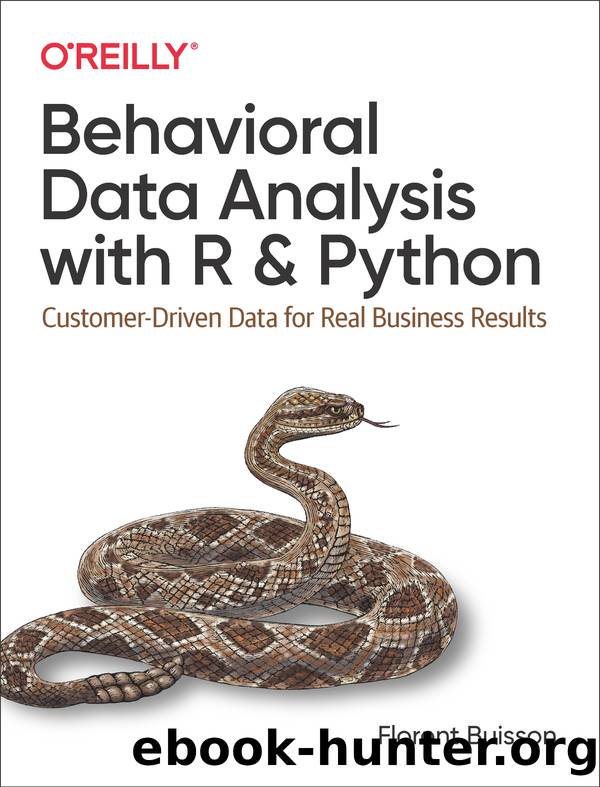Behavioral Data Analysis with R and Python by Florent Buisson

Author:Florent Buisson [Florent Buisson]
Language: eng
Format: epub
ISBN: 9781492061373
Publisher: O'Reilly Media, Inc.
Published: 2021-06-22T00:00:00+00:00
I am no big fan of using an arbitrary number purely because itâs conventional, and you should feel free to adjust the â80% powerâ convention to fit your needs. Using a power of 80% for your relevant threshold effect size would mean that if the intervention had exactly that effect size, on average, you would have a 20% chance of not implementing the intervention because you wrongly got a negative result. For big and costly interventions that are hard to test, my opinion is that itâs too low and I would personally target 90% power. On the other hand, the higher the power you want, the larger your sample size will need to be. You may not want to spend half a year getting absolutely certain of the value of the 1-click button if in that time your competitor has completely revamped their website twice and is eating your lunch.
In my personal experience, one key but often ignored consideration for power analysis and sample size determination in the real world is organizational testing velocity: how many experiments can you run in a year? In many companies, that number is constrained by someoneâs time (either the analystâs or the business partnerâs), by the companyâs planning cycle, by budget limits, etc., but not by the number of customers available. If you can realistically hope to plan, test, and implement only one intervention per year, do you really want to run a three-month experiment and then do nothing for the rest of the year? On the other hand, if you can run one experiment a week, do you really want to spend three months getting certain of a positive but mediocre impact instead of taking 12 chances at a big one? Therefore, after doing the math, you should always do a sanity check of your experiment duration based on your testing velocity and adjust it appropriately.
Regarding statistical significance, the conventional approach introduces an asymmetry between the control and the treatment with a statistical significance threshold of 95%. The bar of evidence the treatment has to pass to get implemented is much higher than for the control, which is implemented by default. Letâs say that youâre setting up a new marketing email campaign and you have two options to test. Why should one version be given the benefit of the doubt over the other? On the other hand, if you have a campaign that has been running for years and for which you have run hundreds of tests, the current version is probably extremely good and a 5% chance of wrongly abandoning it might be too high; the right threshold here might be 99% instead of 95%. More broadly, relying on a conventional value that is the same for all experiments feels to me like a missed opportunity to reflect on the respective costs of false positives and false negatives. In the case of the 1-click button, which is easily reversible and has minimal costs of implementation, I would target a statistical significance threshold of 90% as well.
Download
This site does not store any files on its server. We only index and link to content provided by other sites. Please contact the content providers to delete copyright contents if any and email us, we'll remove relevant links or contents immediately.
Modelling of Convective Heat and Mass Transfer in Rotating Flows by Igor V. Shevchuk(6403)
Weapons of Math Destruction by Cathy O'Neil(6199)
Factfulness: Ten Reasons We're Wrong About the World – and Why Things Are Better Than You Think by Hans Rosling(4709)
A Mind For Numbers: How to Excel at Math and Science (Even If You Flunked Algebra) by Barbara Oakley(3247)
Descartes' Error by Antonio Damasio(3244)
Factfulness_Ten Reasons We're Wrong About the World_and Why Things Are Better Than You Think by Hans Rosling(3216)
TCP IP by Todd Lammle(3150)
Fooled by Randomness: The Hidden Role of Chance in Life and in the Markets by Nassim Nicholas Taleb(3075)
Applied Predictive Modeling by Max Kuhn & Kjell Johnson(3036)
The Tyranny of Metrics by Jerry Z. Muller(3021)
The Book of Numbers by Peter Bentley(2925)
The Great Unknown by Marcus du Sautoy(2656)
Once Upon an Algorithm by Martin Erwig(2613)
Easy Algebra Step-by-Step by Sandra Luna McCune(2598)
Lady Luck by Kristen Ashley(2546)
Police Exams Prep 2018-2019 by Kaplan Test Prep(2511)
Practical Guide To Principal Component Methods in R (Multivariate Analysis Book 2) by Alboukadel Kassambara(2510)
All Things Reconsidered by Bill Thompson III(2367)
Linear Time-Invariant Systems, Behaviors and Modules by Ulrich Oberst & Martin Scheicher & Ingrid Scheicher(2345)
